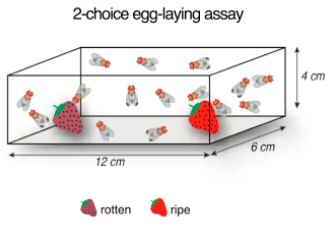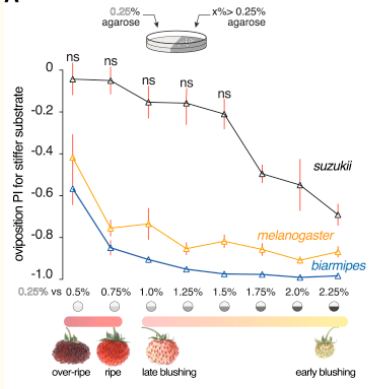A classic insect olfaction study
Runhang / 2020-06-26
Insects constantly receive external cues and adjust their behavior. When a herbivorous insect is targeting the plants, it first replies on olfaction to approach the suitable host plants. Rejecting or accepting the plant host is then involved in gustation and mechanosensation through direct contact. Recent studies have pointed out the gut microbiota contributes to the host animals’ chemosensory responses and behavior. However, little is known about the mechanisms underlying the effects of gut microbes on the host central nervous system. Here, I will give a review of available techniques that can be applied in insect olfaction study.
Example1
A fantastic research paper teach you how to study olfactory system in an non-model organism – D.suzukii
Marianthi Karageorgi et al., 2017; Curr Biol papper
Rational:
- First, they did a set of behavior assays and found out:
- D. suzukii prefer to lay eggs in ripe/fresh fruit over rotten fruit


-
Have implied changes in mechanosensory of D. suzukii, they further examined the olfaction role in oviposition preference. Odors from ripe strawberries can elicit D. suzukii but not D. melanogaster to lay eggs on plain agar
-
Last, they applied Gal4/UAS and CRISPR techniques to manipulate Orco, the obligate co-receptor in odorant receptor system. Silencing Orco gene abolished olfaction-induced egg-laying in a non-choice assay but not affect the flies’ oviposition preference in the two-choice egg-laying assay (The flies prefer ripe fruit over rotten fruit). The data suggested odorant cues, in conjunction with contact chemosensation, contribute to the oviposition behavior of D. suzukii on ripe fruit.
Experimental approaches:
- I have to say that it is the beautiful and well-designed behavior assays that make this article published on Current Biology;
- To verify locomotor activity in mutant flies was not affected, they also did negative geotaxis test - counting how many time the fly acclimated cross the midline of a vail.
- To my best knowledge, although D.suzukii study is getting more popular, this is the first paper to date conducted genetic manipulation using Gal4 and CRISPR on this beast. Specifically, 5’ Orco regulatory regions orthologous to those of D.melanogaster were amplified and subsequently cloned into Gal4 transformation vector.
- Electroantennography (EAG)
- Antibody orco protein staining was performed on fly brains and antennae. Imaging on a confocal microscope.
